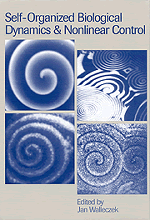 Self-Organized Biological Dynamics and Nonlinear Control
Self-Organized Biological Dynamics and Nonlinear Control Book contents
- Frontmatter
- Contents
- List of contributors
- Preface
- The frontiers and challenges of biodynamics research
- Part I Nonlinear dynamics in biology and response to stimuli
- 1 External signals and internal oscillation dynamics: principal aspects and response of stimulated rhythmic processes
- 2 Nonlinear dynamics in biochemical and biophysical systems: from enzyme kinetics to epilepsy
- 3 Fractal mechanisms in neuronal control: human heartbeat and gait dynamics in health and disease
- 4 Self-organizing dynamics in human sensorimotor coordination and perception
- 5 Signal processing by biochemical reaction networks
- Part II Nonlinear sensitivity of biological systems to electromagnetic stimuli
- Part III Stochastic noise-induced dynamics and transport in biological systems
- Part IV Nonlinear control of biological and other excitable systems
- Index
5 - Signal processing by biochemical reaction networks
Published online by Cambridge University Press: 14 August 2009
- Frontmatter
- Contents
- List of contributors
- Preface
- The frontiers and challenges of biodynamics research
- Part I Nonlinear dynamics in biology and response to stimuli
- 1 External signals and internal oscillation dynamics: principal aspects and response of stimulated rhythmic processes
- 2 Nonlinear dynamics in biochemical and biophysical systems: from enzyme kinetics to epilepsy
- 3 Fractal mechanisms in neuronal control: human heartbeat and gait dynamics in health and disease
- 4 Self-organizing dynamics in human sensorimotor coordination and perception
- 5 Signal processing by biochemical reaction networks
- Part II Nonlinear sensitivity of biological systems to electromagnetic stimuli
- Part III Stochastic noise-induced dynamics and transport in biological systems
- Part IV Nonlinear control of biological and other excitable systems
- Index
Summary
Introduction
One cannot help but be impressed by the engineering, by evolution, of the cellular machinery. The cellular program that governs cell cycle and cell development does so robustly in the face of a fluctuating environment and energy sources. It integrates numerous signals, chemical and otherwise, each of which contains, perhaps, incomplete information of events that the cell must track in order to determine which biochemical subroutines to bring on- and off-line, or slow down and speed up. These signals, which are derived from internal processes, other cells and changes in the extracellular medium, arrive asynchronously and are multi-valued; that is, they are not merely ‘on’ or ‘off’ but have many values of meaning to the cellular apparatus. The cellular program also has a memory of signals that it has received in the past, and of its own particular history as written in the complement and concentrations of chemicals contained in the cell at any instant. These characteristics of robust, integrative, asynchronous, sequential and analog control are the hallmark of cellular control systems. Below, arguments will be made that there is also another characteristic of such control systems: there is often an irreducible nondeterminism in their function that, besides leading to differences in timing of cellular events across an otherwise genetically identical (isogenic) cell population, can also lead to profound differences in cell fate.
- Type
- Chapter
- Information
- Self-Organized Biological Dynamics and Nonlinear ControlToward Understanding Complexity, Chaos and Emergent Function in Living Systems, pp. 112 - 144Publisher: Cambridge University PressPrint publication year: 2000
- 19
- Cited by
